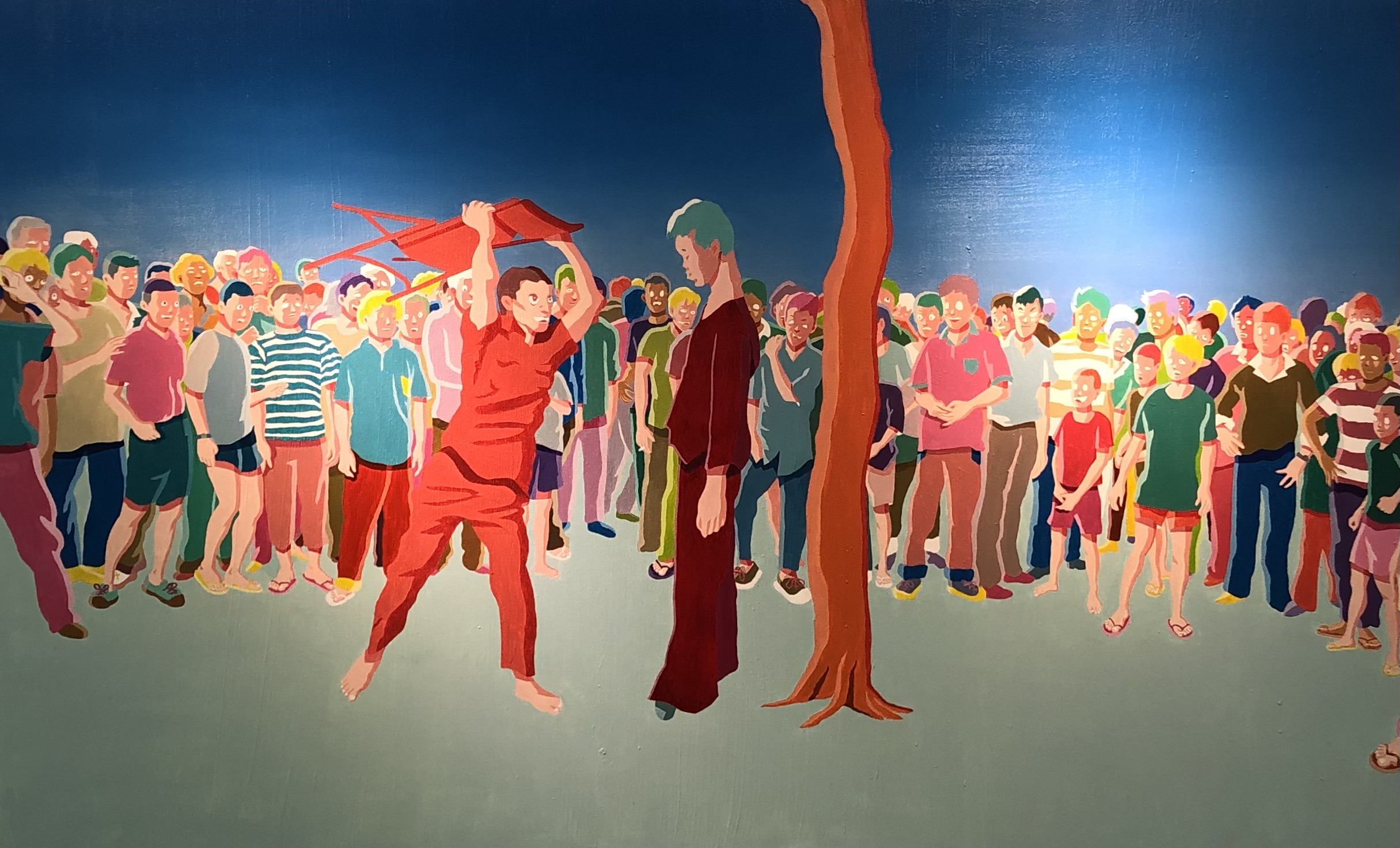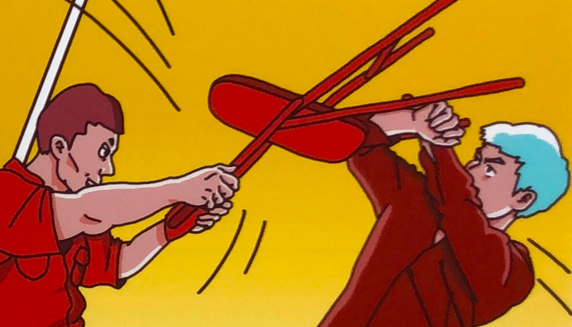
Preecha Raksorn’s Once Upon a Time at Sanamluang... opened yesterday at VS Gallery in Bangkok, and runs until 30th June (a one-week extension of the original exhibition schedule). The exhibition explores the 6th October 1976 massacre at Thammasat University from two opposite perspectives: revisionist history and state propaganda. Preecha focuses on a single image of the event: the famous photograph by Neal Ulevich of a vigilante preparing to hit a hanged man with a folding chair.
Last year, Preecha created A Long Time Ago at..., a large, brightly coloured painting based on Ulevich’s black-and-white photo. The painting reproduces the original image meticulously, with one exception: the noose around the dead man’s neck is missing. This omission, which effectively brings the victim back to life, hints at the revisionist nature of the exhibition.
Preecha reproduced his painting as a line drawing on A4 paper, and gave copies to sixteen people representing a range of ages and occupations, asking them to colour in the drawing in their own styles. With this series, Let’s Color, the artist sought to discover people’s attitudes towards the massacre, and the extent of their knowledge about it, given that Thai school textbooks make only minimal reference to the event.
Last year, Preecha created A Long Time Ago at..., a large, brightly coloured painting based on Ulevich’s black-and-white photo. The painting reproduces the original image meticulously, with one exception: the noose around the dead man’s neck is missing. This omission, which effectively brings the victim back to life, hints at the revisionist nature of the exhibition.
Preecha reproduced his painting as a line drawing on A4 paper, and gave copies to sixteen people representing a range of ages and occupations, asking them to colour in the drawing in their own styles. With this series, Let’s Color, the artist sought to discover people’s attitudes towards the massacre, and the extent of their knowledge about it, given that Thai school textbooks make only minimal reference to the event.




Of the sixteen Let’s Color respondents, only five added the missing noose to their illustrations, suggesting that the state’s suppression of information about the event has been successful. One person, Kwanchai Sinpru, ignored the lines of Preecha’s template and instead overlaid his own paintings of the incendiary media coverage that led to the massacre: a จัตุรัส (‘square’) magazine interview with the monk Kittivuddho Bhikku (29th June 1976), and a Dao Siam (ดาวสยาม) newspaper headline. The most creative response was by Apisit Sitsuntiea, who cut out the drawing to create a paper sculpture in the shape of a crown.
To demonstrate how the massacre is whitewashed by the national curriculum, the exhibition includes a reproduction of a passage from a history textbook that makes only fleeting references to the event. The page (History Lesson of October 6th) has been placed on a lectern, behind which are three framed paintings of massacre victims (Hang Me, Oh Hang Me). This installation resembles a traditional classroom, although in Thai classrooms the three frames would hold portraits of kings and queens instead.
The exhibition was inspired by Quentin Tarantino’s film Once Upon a Time... in Hollywood, in which Tarantino rewrites the Manson Family murder of actress Sharon Tate, creating a fictional happy ending. Preecha uses similar dramatic licence, drawing a comic strip of twenty-six panels, Once Upon a Time at..., in which the hanged man removes the noose from his neck, fights back against the vigilante, and escapes. Over the years, many artists have reproduced elements from the Ulevich photograph, though Preecha’s comic responds to it in a surprisingly unique and original way.


To demonstrate how the massacre is whitewashed by the national curriculum, the exhibition includes a reproduction of a passage from a history textbook that makes only fleeting references to the event. The page (History Lesson of October 6th) has been placed on a lectern, behind which are three framed paintings of massacre victims (Hang Me, Oh Hang Me). This installation resembles a traditional classroom, although in Thai classrooms the three frames would hold portraits of kings and queens instead.
The exhibition was inspired by Quentin Tarantino’s film Once Upon a Time... in Hollywood, in which Tarantino rewrites the Manson Family murder of actress Sharon Tate, creating a fictional happy ending. Preecha uses similar dramatic licence, drawing a comic strip of twenty-six panels, Once Upon a Time at..., in which the hanged man removes the noose from his neck, fights back against the vigilante, and escapes. Over the years, many artists have reproduced elements from the Ulevich photograph, though Preecha’s comic responds to it in a surprisingly unique and original way.


